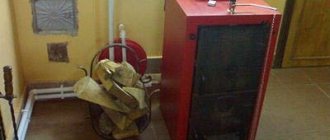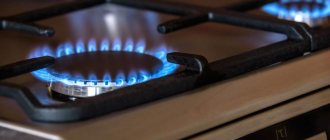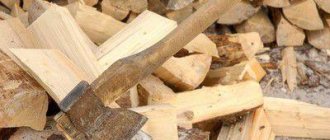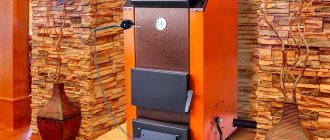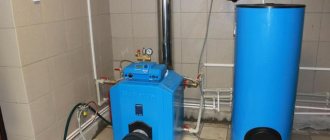How many cubic meters of firewood do you need for the winter?
To find out how much firewood is needed for the winter, you need to consider several factors. In addition to the percentage of moisture and type of wood, you should definitely look at the type of logs (round, split, a mixture of two types). A significant factor is the length of time during which the home will be heated. In many Russian regions, it takes a long time to heat houses - for 6–7 months. All this affects how many cubic meters of spruce and oak will be required to maintain a comfortable atmosphere in the rooms. The longer the boiler system operates, the more combustion material will be used.
What you need to know to calculate
How much firewood is needed to heat a house depends on several factors:
- the amount of thermal power spent on heating;
- equipment in use;
- types of wood;
- wood humidity.
According to the standards, the thermal power is 1 kW of heat per 10 sq. m in extreme cold. The average value is 0.5 kW. Thus, for a building of 100 sq. m it will be 5 kW.
The more spacious the housing, the higher the fuel consumption. The efficiency of different types of heating devices differs. For most solid fuel boilers this parameter reaches 70–75%. Pyrolysis models are more efficient - their efficiency reaches 80%. Russian and steel stoves have the lowest heat output. Their efficiency on average is 65%, 55%, respectively.
Deciduous and coniferous trees are used for heating. Birch has the highest heat transfer – 2371 kW/cu.m. m at 50% moisture content and 2716 kW/cu.m. m at 20% water content. The minimum calorific value of a Christmas tree is 1667 kW/m3 at a humidity of 50% and 1902 kW/m3 at a moisture content of 20%.
| Wood type | Calorific value of freshly cut wood at 50% humidity, kW/m3 | Calorific value of semi-dry wood 30% humidity | Calorific value of dry wood 20% humidity, kW/m3 |
| Pine | 1900 | 2071 | 2166 |
| Birch | 2371 | 2579 | 2716 |
| Spruce | 1667 | 1817 | 1902 |
| Aspen | 1835 | 1995 | 2117 |
| Alder | 1972 | 2148 | 2244 |
| Ash | 2550 | 2774 | 2907 |
Table 1. The calorific value of firewood of different types, related to the measure of volume - 1 m³.
When preparing for wintering, you need to know how to calculate cubes of firewood. For this purpose, special formulas have been developed to calculate the norm of logs for the autumn-winter season.
Basic ways to save heat
Economical heating of a private house with wood has become possible thanks to the use of modern stoves: fireplaces with closed fireboxes have doubled the efficiency, and it reaches 75%, just like good gas stoves.
Even if you decide to install a regular Russian stove, its efficiency can also vary significantly. This depends on the materials, the correctness of the masonry, and the performance of the chimney. A wood heating stove with an efficiency of 90% remains an unattainable dream for many: so far only high-tech gas equipment can boast such efficiency.
When heating a house with wood, consumption can be reduced using simple “rustic” methods that have been used for decades. A few basic measures will make it possible to significantly reduce heating costs:
The optimal amount of heat is provided only by dry firewood, the combustion of which produces clear smoke with a pleasant woody smell. When burning wet wood, white steam appears - the evaporation of water leads to wasted heat loss and ineffective combustion of fuel.
It is not difficult to distinguish dry wood: if you hit one log on another, the sound should be clear. It is important to ensure that firewood is stored correctly so that it will always be ready for use.
The efficiency of the stove is significantly reduced if the chimney is clogged with ash and soot. At the same time, traction deteriorates, and due to an insufficient supply of oxygen, the fuel does not burn completely, giving off a minimum of heat.
In addition, toxic carbon monoxide can be released, which can negatively affect human health. Regular cleaning of furnaces can completely solve the problem: removing soot from the walls increases the performance of the entire system.
There is another method, which, according to home owners, makes it possible to reduce fuel consumption by half. It involves taking combustion air not from the room, but from the street: the increased flow of oxygen allows the wood to burn out entirely, while it will not take heat from the house.
Thus, modern gas boilers are initially designed to take air from the street. When modifying the design, the stove can take air from the basement of the house.
The most important condition for saving fuel is proper insulation of the house. It is necessary to insulate not only the walls, but also the floor, foundation, and roof.
Most of the heat simply leaves the house through unsealed cracks in the walls or cold bridges in the under-roof space. For your home, you can use modern insulation in combination with waterproofing and vapor barrier membranes.
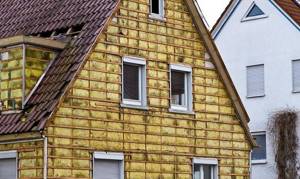
An economical wood-burning stove for heating a house involves the use of a water or air circuit for heating. In this case, the heat will be evenly distributed throughout the rooms, and for this it is not necessary to use a large amount of fuel.
Such heating is possible by installing an additional heat exchanger in the furnace structure: the most common solution is the so-called “water jacket”. The water is heated by the combustion of fuel and enters the piping system to the radiators, after which it returns to the furnace.
This heating system eliminates the main drawback of a traditional wood stove: uneven heating of the air in the rooms. If it is always very warm near the stove, then in distant rooms the air will always be much colder. If you install radiators and turn an ordinary stove into a solid fuel boiler, this will allow you to warm up every room.
How is fuel calculated for the season?
How to calculate firewood for heating a house:
V = 720 * Q / (q * 0.01 efficiency), where
720 – number of hours per month (24 hours * 30 days);
V – amount of biofuel for one month;
Q – heat required to heat the building (kilowatt-hour);
q is the calorific value of 1 cubic meter of wood depending on the degree of drying (kW/m3);
Efficiency – efficiency of the heating device (%).
| Length, m | Full wood coefficient for logs | |||||||
| Conifers | Hardwood | |||||||
| Round | Broken | A mixture of round and chopped | Round | Broken | A mixture of round and chopped | |||
| thin | average | thin | average | |||||
| 0,25 0,33 0,50 0,75 1,00 1,25 1,50 2,00 2,50 3,00 | 0,79 0,77 0,74 0,71 0,69 0,67 0,66 0,64 0,62 0,61 | 0,81 0,79 0,76 0,74 0,72 0,71 0,703 0,68 0,67 0,65 | 0,77 0,75 0,73 0,71 0,70 0,69 0,68 0,66 0,64 0,63 | 0,77 0,75 0,73 0,72 0,70 0,69 0,68 0,67 0,66 0,65 | 0,75 0,72 0,69 0,65 0,63 0,61 0,60 0,58 0,56 0,55 | 0,80 0,78 0,75 0,72 0,70 0,68 0,67 0,65 0,63 0,62 | 0,76 0,74 0,71 0,69 0,68 0,67 0,65 0,63 0,62 0,60 | 0,76 0,74 0,71 0,69 0,68 0,67 0,66 0,65 0,64 0,63 |
Table 2. Full wood coefficient for logs
The result will be a value that will show the optimal volume of birch, spruce, ash to provide the living space with heat. But these are not ready-made logs that are put into the oven. To find out how much firewood is needed to heat a house, you need to divide the found value by the conversion factor. Each type of tree has its own. In addition, the shape, footage and thickness of the log are taken into account. For example, if it is round, of medium thickness, coniferous, then with a length of 50 cm the conversion factor is 0.72.
To obtain the amount of solid fuel for the full season autumn - spring, you will need to multiply the resulting value by the number of months of the year in which the building will be heated.
The optimal time of year for harvesting work
Procuring firewood for the winter is not just about cutting down a tree and cutting it into logs. It is necessary to ensure optimal storage conditions that ensure good drying of the wood. In addition, you need to know that the most optimal time of year to perform this work is the end of autumn and the beginning of winter. But the weather should not be rainy. The choice of this period is determined by the following factors:
- cutting down trees without leaves is easier;
- after the first frost, the logs are easier to split;
- in late autumn, the movement of sap stops, which makes it possible to obtain wood with a lower percentage of moisture.
All the forest cut down at this time of year is sawn into logs, chopped down, and the logs are sent for long drying until next autumn. You should not immediately throw them into the oven or boiler. From raw solid fuel you can only get a lot of soot, which will settle in the chimney as soot. For heating, logs from last year's harvest are used. They will give off maximum heat and minimum smoke. New firewood will be supplied next year
In order for the logs to dry well, it is important to provide good ventilation and protection from precipitation.
In the video you can see the process of collecting firewood:
When collecting firewood, it is not necessary to cut the forest yourself. After all, these logs will then have to be transported home. There are many companies providing this service. For really lazy people, hired workers can split logs into logs. In this case, your own labor costs will decrease, but the cost of solid fuel will increase.
fermilon.ru
Calculation of firewood consumption for heating a house of 100 m2
How much firewood is needed to heat 100 m2 can be easily calculated using the previously stated formula. In the example, we will consider the option of using 50 cm chopped pine logs that have been pre-dried. They will be burned in a pyrolysis boiler, which has an efficiency of 80%. Heat consumption for heating (Q) during the frosty season is approximately five kilowatts per hour.
The calorific value (q) for dried pine is 2166 kW per cubic meter. It must be substituted into the formula. Result:
V = 720 * 5 / (2166 * 0.01 * 80) = 2.08.
The second stage is to determine the rate of split pine, calculated in folding meters. It is equal to 0.73. We perform arithmetic operations:
2.08 / 0.73 = 2.85 cubic meters m.
Let’s assume that the building is planned to be heated for five months. The calculated value must be multiplied by them. It turns out that you will need 2.85 * 5 = 14.25 m3 of dried pine.
To understand how much wood is needed to heat structures of 150 m2, 200 m2, the final figures are increased by one and a half to two times.

